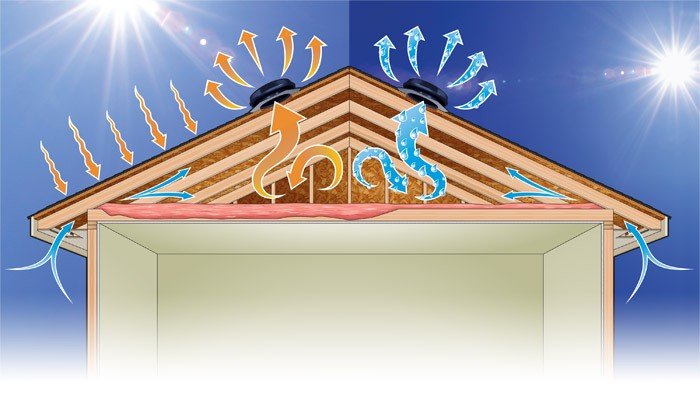Solar Star, our solar-powered roof ventilator, is truly a thing of beauty. We told you All About SolarStar not too long ago. Solar Star combines value, functionality and innovation to create a product that simply does its job better and more efficiently than anything else out there.
But, why do you need mechanical roof ventilation? Well, if you have full ridge and soffit vents, then you probably don’t. However, if your roof cavity isn’t already well ventilated, then adding a Solar Star photovoltaic ventilator may help to lower your air conditioning load in the summer and reduce the risk of moisture damage to your roof insulation and roof structure, too. Here’s how and why.
Why Use Roof Ventilation?
These days, roof cavities are built to minimise the infiltration of air from the house below and provide plenty of insulation at roof cavity level. That means the roof cavity is essentially an indoor/outdoor area, not part of the conditioned interior. However, very few houses have such an airtight top floor ceiling that warm, moist air doesn’t manage to find its way up to the roof. The humid air comes up through the roof hatch, through the pot lights and through electrical and mechanical penetrations.
Once the air gets past the insulation during the winter, it is in a colder environment. It will rise up to the roof structure and condense into liquid water, eventually rotting the timber if the underside of the roof stays damp. In addition, if the condensation drips onto the roof insulation, that will greatly reduce its effectiveness; wet insulation is close to useless. Roof vents allow the warm, moist air from the living areas to escape from your roof cavity rather than condensing and causing problems. That’s how Solar Star can help to protect your roof structure and improve thermal performance in the winter.
In the summer, ventilation will keep your roof cavity from getting too hot. A cooler roof cavity, where hot air can escape to the exterior, will reduce the need for air conditioning in the house and save you money on energy. When you have a metal roof or a dark coloured roof, the roof cavity is especially likely to absorb heat and radiate it into the rest of the house. A Solar Star ventilation fan will work hardest exactly when it’s needed most: when the sun is bright and direct.

What About Winter Heat Loss?
Ideally, heat loss from your roof is not a problem. Modern, well constructed houses are designed to have roof cavities that are ventilated all year and that are not used as living space. They are insulated at floor level, so the space above floor level can be the same temperature as the exterior. It’s okay if this type of roof is cold in the winter. In fact, a cold roof can help to prevent dangerous icicles from forming along the eaves and soffits if the temperature goes below zero.
However, some families use their roof space for storage and/or are partially or fully heating it because of extensive air leakage from below, or because it isn’t well insulated. If you do have an roof cavity that isn’t well isolated from your living area, please note that Solar Star has an optional temperature sensor that will ensure that it only runs when it’s over 18°C outside.
If you’re not sure whether or not your house would benefit from Solar Star, then give us a call. We can tell you exactly what to look for in determining how well ventilated your roof cavity is now and whether or not more ventilation would benefit you. We can also help you determine whether your roof cavity is fully conditioned, partially conditioned or thermally isolated. Depending on where you’re located, we may even be able to pay you a visit. Don’t hesitate to drop us an e-mail or give us a call on 1800 131 619.


I would like to enquire how much will a roof ventilation cost?
Hi Joseph,
There are two Solar Star models available. Your local dealer will be able to recommend the appropriate model based on the specifications of your home e.g. double or single storey, building footprint, roof type etc. Generally a single RM-1600 is sufficient on the majority of homes, while the V-AERO is more suitable for smaller homes and roof spaces or where the property has a bushfire attack rating (optional ember guards available, larger homes within bushfire zones may require multiple V-AERO units). As a guide, the V-AERO is approx. $400 and the RM-1600 is approx. $720 (includes roof flashing kits). Installation prices vary across Australia, please reply with your post code if you would like the tel. number or email for your local dealer to obtain a full quote including installation.
What a fantastic piece of work! Thank you very much for your informative information!